Menu
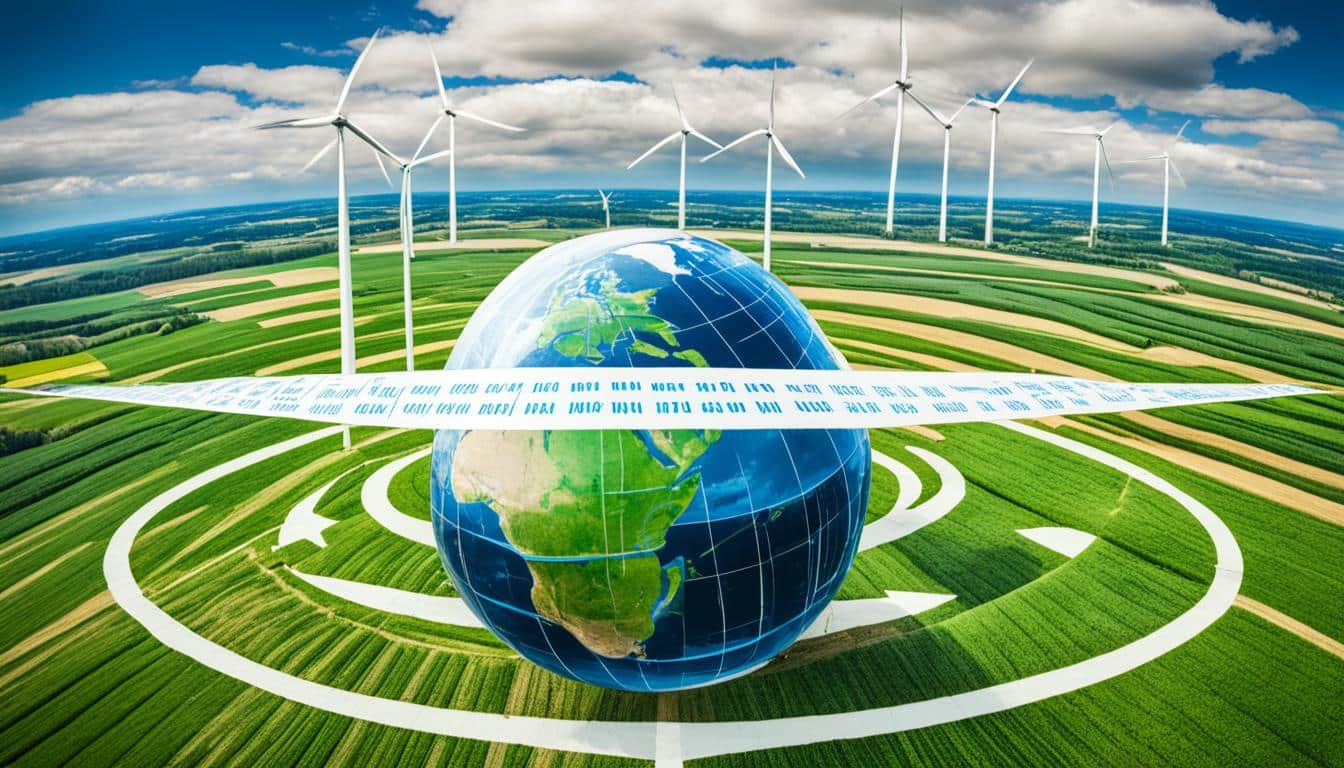
Did you know that the global agrifood system emits about a third of all emissions? This fact highlights the need for farming to adjust to global climate rules. As temperatures worldwide increase, causing more droughts, adopting sustainable farming practices is crucial.In the United States, international rules on climate change are changing how all farming parts operate, from growing crops to raising animals and managing land. The USDA’s studies show that farmers must change with the weather to cut down on harmful gases. The Fourth U.S. National Climate Assessment warns about the warmer weather and changing rain patterns. This alters when crops grow and increases pest problems for farmers. To handle these problems, new international rules aim to lower nitrous oxide and methane. They encourage using new technology like capturing carbon and using more renewable energy.
The world knows it must slow down climate change in farming. Many rules and agreements try to cool the planet and cut the gases we release. These global rules are key for keeping farming green and saving forests and animals.
The Montreal Protocol has all but wiped out harmful chemicals that ruin our ozone layer. The Kyoto Protocol started the trend by telling rich countries to cut their pollution. Now, the Paris Agreement aims to stop the earth from getting too hot and reach zero emissions worldwide. America once left this pact but came back under new leadership, showing how views on climate change can change.
America, as the second-largest polluter, is vital in these big plans. But, recent checks show we’re not doing enough yet. With a big push from everyone, we might still hit our climate change goals.
The Intergovernmental Panel on Climate Change (IPCC) started back in 1988. They tell us what we need to know about the changing climate. Countries, helped by the likes of the European Union (EU) and groups like the World Bank, make and follow through with big climate promises.
The European Environment Agency (EEA) gives us the facts we need to fight climate change. We now have thousands of laws for nature-friendly farming, making a big difference. In places where rules are strict, new laws have cut CO2 a bit more every year.
Though most pollution happened in wealthy countries, places like China and India cause a lot now. Solving this problem needs everyone, old and new big polluters, to work together. This is the only way to keep the earth cooler and our farms safe for the future.
The effects of climate change on crops are big. We need to start using farming methods and rules that are good for the climate. This will help keep farming sustainable for the future.

Over the past 115 years, global temperatures have gone up by 1.8°F (1.0°C). This has a big effect on how much food we can grow. The U.S. Environmental Protection Agency (EPA) says that in 2021, farming made 10.6 percent of all the greenhouse gases in America. That’s a lot, equal to 671.5 million metric tons of gas.
The economy is hit because of these changes, especially with more extreme weather. Crops that don’t get watered are producing less, leading to big money losses. But, there’s hope; U.S. corn might grow 3.1 percent more by 2036. Yet, soybean could drop by 3.0 percent. This will affect both the food we have in the U.S. and what we sell to other countries.
To fight back against climate change, we must change the types of crops we grow. Making drought-resistant plants is key. In 2016, drought-ready corn made up 22 percent of the corn fields in the U.S. This step helps follow the new farming rules and makes farms stronger and more sustainable.
| Crop Type | Projected Change in Yield | Region Impacted |
|---|---|---|
| Wheat | +17% | Northern U.S., Canada, China Plains |
| Maize | -24% | North and Central America, West Africa, Central Asia, Brazil, China |
| Soybeans | -3% | United States |
The AgMIP uses 240 models from the CMIP6 project to predict how climate change will affect crops. Such methods are crucial for choosing the right crops to grow in the future. This is important for keeping farming sustainable and following new farming rules that are good for the planet.
Greenhouse gas emissions from livestock are a key concern in agriculture. The U.S. Environmental Protection Agency (EPA) reported that in 2021, 10.6 percent of America’s emissions came from farming. A big chunk of this total was from animals.
Livestock, especially through methane, is a leading emitter of greenhouse gases. 2021 saw U.S. farms produce a whopping 671.5 million metric tons of these gases. Of this, 46.6 percent was nitrous oxide, 41.5 percent was methane, and 11.9 percent was carbon dioxide.
This data highlights the urgent need for strict emission control rules in farming to lessen these impacts.
Global climate rules push for better ways to track and lessen livestock-related greenhouse gases. A main tactic is to improve how farms are run. For instance, changing what animals eat can cut down on methane a lot.
| Outcome | Measure |
|---|---|
| Increased productivity | Improved feed efficiency |
| Reduced methane emissions | Optimised animal diet |
| Enhanced resilience | Genetically adapted breeds |
| Lower greenhouse gas emissions | Manure management |
Also, choosing animals that can handle hotter weather and tougher climates can cut down on need for help from farms. This is not only good for our planet but also key for keeping animals well and working well.
The USDA Climate Hubs give farmers tools to make wise decisions on climate, stressing solutions designed for local needs.
In ending, strict farming rules on emissions promote the use of smart, eco-friendly farming. This is crucial for tackling farming’s emission issues. With the right actions, we can make farming better for the planet and the animals.
Climate policies are changing how we use land. They aim to turn agriculture areas into forests. This change helps lower carbon footprints and follows farming regulations involved in reducing climate change.
Since 1960, the world has changed by about 720,000 square kilometres of land every year. However, this change has slowed down since 2005 due to global economic changes, especially after the 2007-2008 financial crisis. Nearly 32% of Earth’s land has been affected by these shifts, with the growth of agriculture as a main factor.
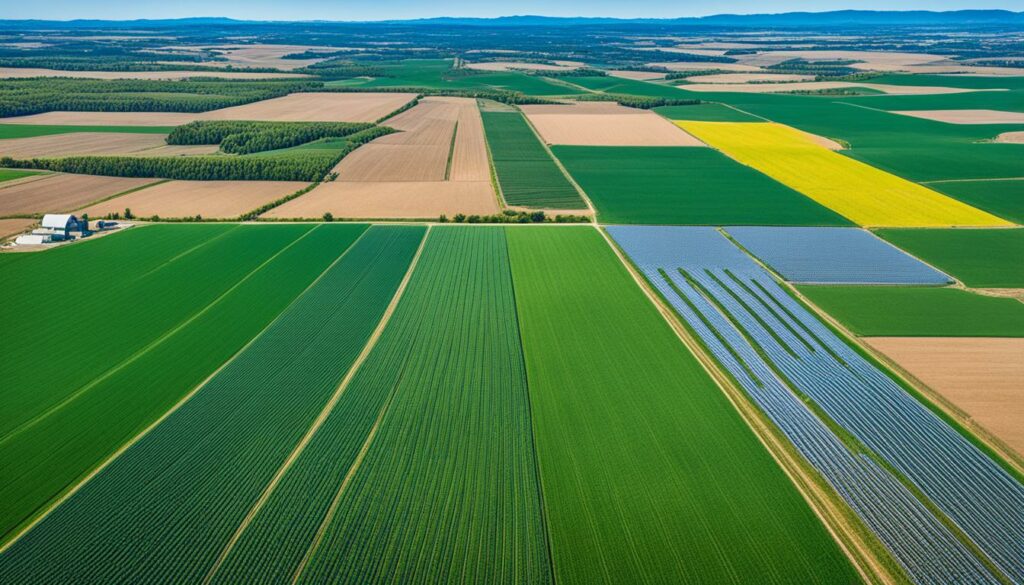
From 2007 to 2016, around a quarter of human greenhouse gas emissions came from how we use land. By turning farm areas into forests, we can better balance greenhouse gas levels. This shows how important these changes really are.
Human activity has affected about 75% of Earth’s land. Agriculture plays a big part in this. Policies encouraging the change to forests from farms help wildlife by providing new homes. But, this can make farming more challenging, affecting food production and jobs.
The changes in land use show how agriculture responds to outside factors. For example, 86% of changes are linked to farming. This shows how active the sector is in addressing climate issues.
| Land-use Changes | Impact |
|---|---|
| Annual Land Surface Change | 720,000 km² |
| Impact of Global Financial Crisis on Deceleration | Post-2005 |
| Human-caused Greenhouse Gas Emissions Due to Land Use (2007-2016) | 25% |
| Land Surface Altered by Humans | 75% |
| Agriculture-related Multiple-change Events | 86% |
This change in land use, driven by climate policies, has good and bad sides. It helps cut carbon footprints and protects wildlife. But, we need to manage it carefully to make sure we can still grow food and keep the land healthy.
Global warming has caused temperatures to increase by about 1.8°F (1.0°C) in the past 115 years. The world’s farms are now dealing with bigger challenges. The change in climate has big effects on how much crops cost and how safe our food is.
Global warming has made crop prices more unstable. With rising temperatures, crops are not growing as well in places like southern Europe. This means it costs more to produce these crops. For example, the Environmental Protection Agency (EPA) stated in 2021 that U.S. farms released 671.5 million tons of greenhouse gases. Efforts to control these emissions make farming more expensive.
Food security is also at risk because of climate change. The growing global population by 2050 means we need more food. But, extreme weather and climate changes are making it hard to grow enough. The U.S. Department of Agriculture (USDA) is trying to help by investing $2.8 billion in 70 projects to support farmers. Still, the challenge from global warming remains.
| Year | Crops Yielded | Impact on Prices | Food Security Initiatives |
|---|---|---|---|
| 2016 | 22% drought-tolerant corn | Moderate impact | Conservation programs increase |
| 2021 | Various crops | High impact due to emissions | $330 million in regional partnerships |
| Future (Predicted) | Reduced yields | Significant price hikes | Ongoing investments in climate-smart practices |
The world is seeing more 100-year floods and severe droughts. This is changing how we look at farming. Sustainable farming is key in this new climate. It helps farms bounce back and cuts down on greenhouse gases. The NSAC champions solutions that focus on everything involved in farming, from people to plants.
Indigenous knowledge has inspired conservation agriculture. It aims for little soil disruption, always keeping soil covered, and mixing up the kinds of plants grown. This approach doesn’t just keep the soil and water healthy but also traps carbon. To really work, farmers need help like grants and loans. This supports farming that’s good for the planet.
Agroforestry brings trees and shrubs into farmlands. It boosts biodiversity, helps with water, and locks away carbon. This method fits well with both good farming practices and rules that protect the environment. By using agroforestry, farmers make their land stronger. This helps nature and local communities. The Agriculture Resilience Act is working to get farmers what they need to try these better practices.
“Farmers and ranchers of colour, recognised experts in ecologically appropriate practices, should have a meaningful role in shaping policy.” — National Sustainable Agriculture Coalition
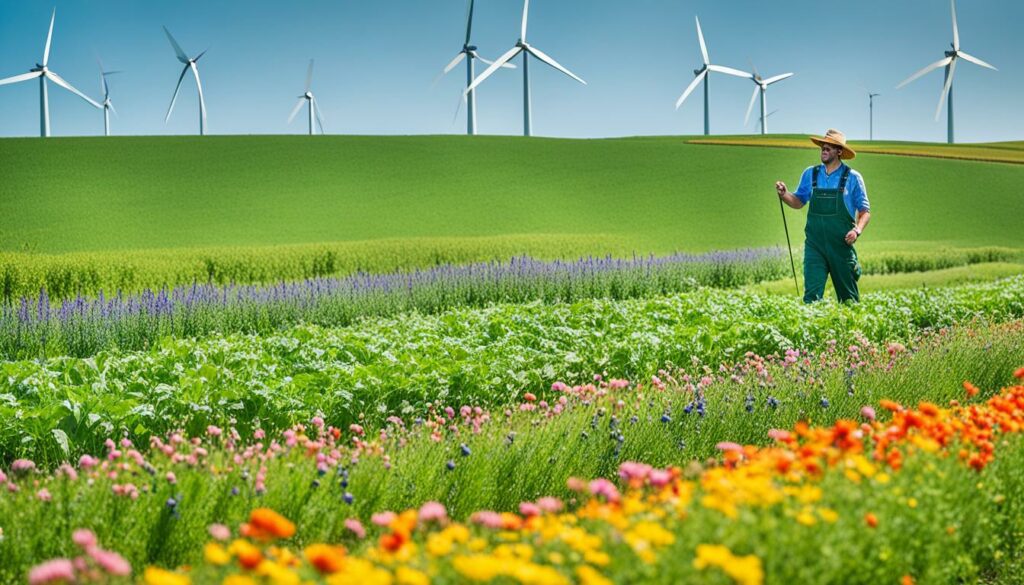
It’s key to have public backing for farm systems that improve health and the planet. A lot of studies prove the benefits of farming organically for the climate. Adding practices like smart tilling, varied planting, and careful nutrient use really cuts down on climate harm.
Climate change is a big problem for farming worldwide. It makes different regions come up with special plans to fight its effects. Europe and the United States are leading the way in finding ways to keep farming viable.
In Europe, the south is hit hard by extreme weather events. These events affect food and animal feed production, pushing for new solutions. One key tactic is mixing up crops and growing plants that can handle drought.
Europe uses guidance from the European Environment Agency to boost its efforts. This guidance aims to keep farming practices eco-friendly and in line with the law. It helps make the adaptations stronger and more planet-friendly.
The United States also faces climate challenges. It has set up a big plan to fight back. The USDA’s Plan for Climate Adaptation and Resilience of 2021 is at the heart of these efforts.
got a boost in 2022 with new focuses, like fair treatment and work with Native American groups. They use smart farming and various crop planting to make farming tougher. These changes help the U.S. land better fight the changing climate.
Furthermore, the USDA has a new rule saying all activities must fight climate change. This includes support for cleaner forests and more climate-friendly farming. With agencies fully on board, this plan is getting into action.
Together, these moves show a powerful effort to tackle climate change in farming. They prove that making smart, local plans works in beating climate threats.
International climate change regulations impact farming worldwide. These rules are set by the United Nations Framework Convention on Climate Change (UNFCCC). They push nations to lower emissions and use more sustainable farming methods. This means taking better care of the land and helping farmers financially.
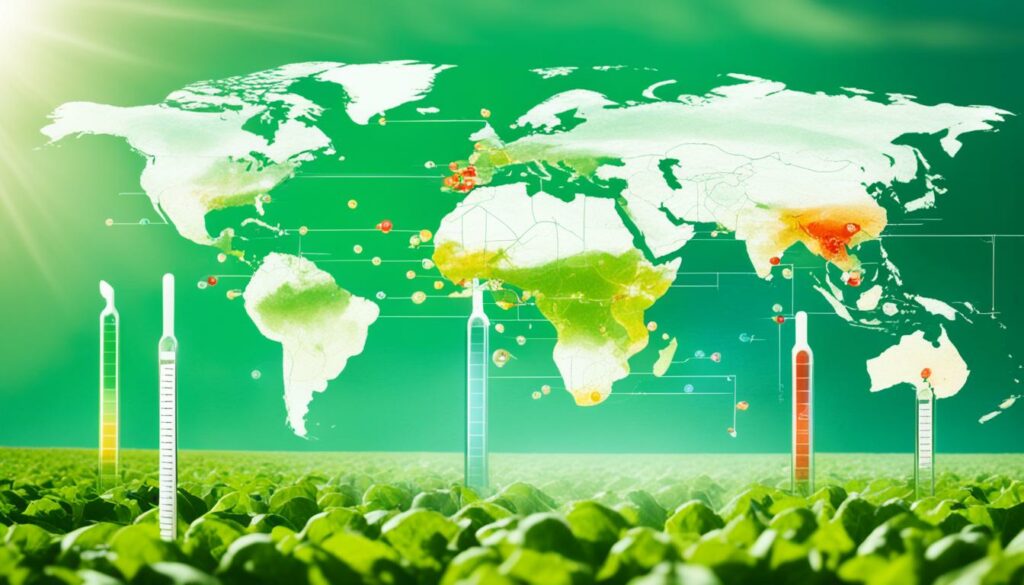
In the European Union, agriculture makes up about 10% of greenhouse gases. But, efforts to reduce emissions are working. For example, methane from cows has dropped by 21% since 1990. The EU has also cut its overall farm emission by 19% thanks to eco-friendly policies.
A key policy is the EU’s Common Agricultural Policy (CAP), with green payments. These payments encourage farmers to look after grasslands, grow different crops, and set aside land for nature. The latest CAP also focuses on funding schemes that help fight climate change.
These policies are changing farming for the better. Here are four ways:
Agriculture is key in lowering climate change’s effects. The U.S., for instance, released a lot of carbon in 2021 from farming. To cut this number, the U.S. is pushing for eco-friendlier farming methods. This includes using fertilisers better, growing crops that can handle droughts, and improving how they look after animals.
With global temperatures rising by 1.8°F (1.0°C) in the last 115 years, we must act. Stronger international farming rules are vital to protect our food and future.
The earth’s changing climate leads to more and worse droughts. To keep farming sustainable, we need strong plans to fight these dry spells. Thanks to new tech and government help, dealing with drought is getting easier.
New technologies are key in fighting drought’s effects. For example, precision irrigation lets us water crops exactly right. This cuts down on water wasted. Also, things like mulching and cover crops make soil better. This means it holds more water, which is great during dry times. Action like this even helps with rules about farming and the climate.
Below is a table that highlights some of the key technological innovations and their benefits:
| Innovation | Benefit |
|---|---|
| Precision Irrigation Systems | Improves water efficiency and reduces wastage |
| Soil Health Practices | Increases soil organic matter, retaining more water |
| Rotational Grazing | Relieves pressure on vegetation and ensures reliable water sources for livestock |
Special government help is crucial for farms during droughts. Acts like the IRA and Agriculture Resilience Act do a lot. The IRA funds steps to lower farm emissions and make farms stronger. But, the Agriculture Resilience Act goes further. It helps with research, local sales, and waste handling.
The USDA’s Natural Resources Conservation Service supports key farming practices. These include saving water and looking after soil. They also help farms prepare for dry times. This is very important for farming’s future with our changing climate.
Even small changes in soil can save lots of water and add more plant food. NRCS is there to help farms have water even in the worst dry spells. This is important to keep things growing, whatever the weather.
New tech and government aid are our best bets against drought. A mix of modern tools and strong support could mean a brighter farming future.
Climate change makes it crucial to cut the carbon footprint of farming. The EPA states that U.S. farms produced 671.5 million metric tons of carbon-dioxide equivalents in 2021. This is a big part of worldwide greenhouse gases.
Our main aim is to adopt methods that keep the carbon locked in the soil. This helps in fighting climate change.
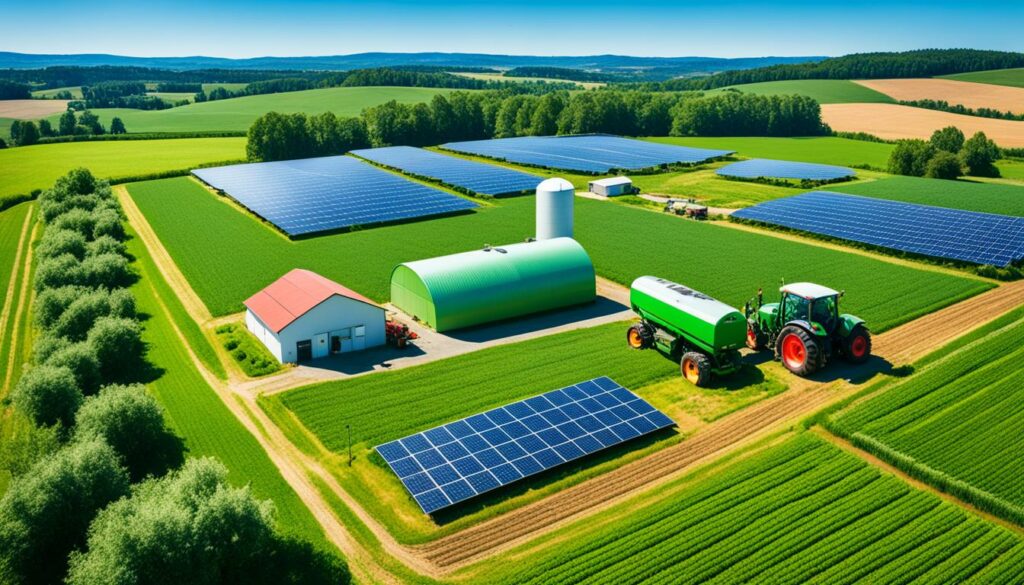
Keeping carbon in the ground is key to lowering farm emissions. Agroforestry, which adds trees to farms, captures carbon. It also boosts life variety and soil quality.
In 2021, the USA put 754.2 million metric tons of carbon in the land. This shows the power of such methods.
Reducing farm emissions needs smart strategies. Using drones to measure nitrogen helps in using fertilisers better. This cuts down nitrous oxide, a large part of farm emissions.
Other helpful tactics include using clean energy on farms. Also, managing animal waste with anaerobic digesters lessens green gases.
In short, we need to both store carbon in the soil and lower harmful gases. Doing this can make farming more eco-friendly. It also meets global efforts to protect our planet.
Climate change is making water more precious and efficient water management in farming is key. The Yakima River Reservoir system provides water for over 450,000 acres but struggles with shortages. These could get worse reaching up to 77% by the 2080s. Even with a better scenario, we might face water problems in around 50% of the years by the 2080s.
To tackle these issues, farmers should use farming methods that save water and withstand climate changes. New tools like drip irrigation and systems that check soil moisture are very helpful. They can lessen the impact of water shortages.
Using water carefully is a must for farming that lasts. Things like rotating crops and tilling less can help keep water and cut down on the need for irrigation. For instance, in Washington State’s Yakima River basin, about 34% of the used land grows fruits and makes wine. These steps keep these valuable crops growing well, even when water is short.
New irrigation tools play a big part in farming that helps our climate. Apart from the usual, things like smart sprinklers and soil moisture watching can make how we use water much better. These tools meet the need for farming that’s both long-lasting and prepared for climate changes.
Plus, in Washington, the Cascade Mountains could lose a lot of their snowy start to spring. Just a 1°C rise could cut snowmelt by 12%. With a 2°C rise, it could mean 27% less snowmelt. Farming in regions like Yakima, relying greatly on snow and reservoirs, needs to change with the weather. It’s about keeping farming alive in these areas.
Climate change puts our farming future at risk. That’s why we have strict rules on pesticides and fertilisers. These rules help keep our soil healthy and protect the environment. They are key for farming in ways that lower greenhouse gases but still grow plenty of food.
Modern farming relies on chemicals that hurt our planet. Almost all these chemicals come from fossil fuels. Making just one kilogram of pesticide uses ten times more energy than making fertiliser. This all adds up to more greenhouse gases from farming.
Climate change makes pesticides break down faster. This means we have to use more, which is bad for the environment. When it rains hard, pesticides can wash into our water, harming wildlife. So, following the rules is crucial.
Following regulations means using farming methods that are good for the earth. With the weather getting hotter and rains changing, we need to adapt. Agroecology is one such farming method that helps us use fewer harmful chemicals.
People at risk from these chemicals, like farm workers and those living in the country, are often from low-income backgrounds or are people of colour. Governments must act to use fewer pesticides. This will keep us healthy and protect our planet.
Below is a comparative table summarising the energy requirements and impacts of pesticides and fertilisers:
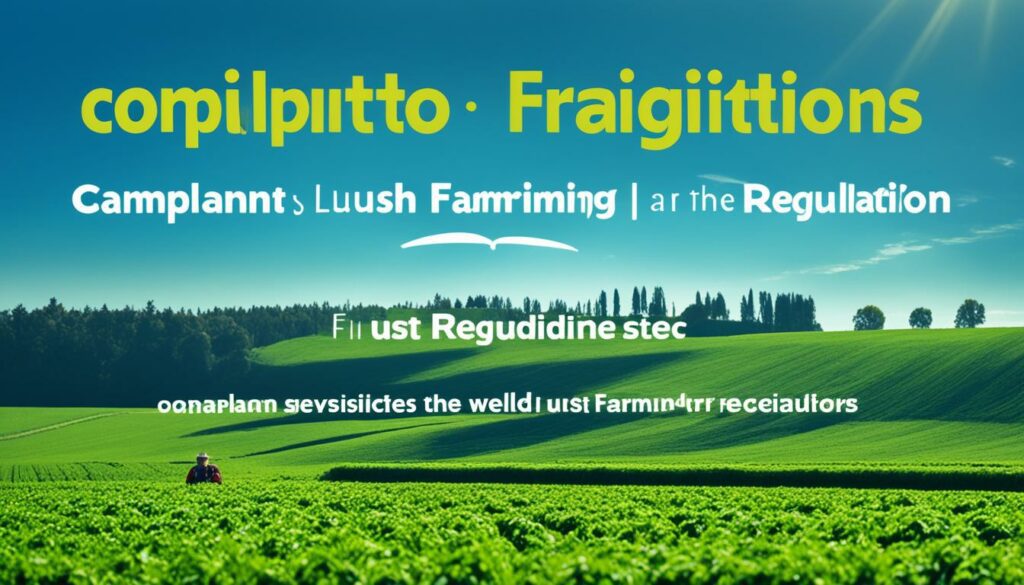
| Aspect | Pesticides | Fertilisers |
|---|---|---|
| Energy Requirement (per kg) | 10 times higher than fertilisers | Lower |
| Derived from Fossil Fuels | 99% | 99% |
| Effect on Greenhouse Gases | Increases nitrous oxide | Increases methane and nitrous oxide |
| Degradation Speed due to Climate Change | Accelerated | Less affected |
| Impact on Waterways | High (with severe rain events) | Moderate |
Sticking to the rules helps the environment and encourages better farming. This approach is vital in fighting the harmful effects of farming on climate and soil. It helps leave a better planet for those who come after us.
Our future in farming is changing fast due to climate change agricultural industry regulations. It’s clear that investing in technological innovations in agriculture is key. By 2050, we must find new ways to grow food for 9.7 billion people that are good for the planet.
Thanks to new technology, we’re using our resources better and getting higher yields. Despite a third of emissions coming from farming, we’re making progress. For example, we now have plants that can survive harsh weather without needing harmful chemicals to grow.
But it’s not just about high-tech gadgets. Simple ideas like rotating crops or planting different things together are also making a big difference. These methods use space better without causing more harm to the environment. With agriculture using 70% of the world’s fresh water, saving water is also a top priority.
Big groups like the World Bank are putting more money into farming that’s good for the climate. However, only a tiny bit of this money goes to small farmers. Some special projects are focusing on helping farmers in places like China and Africa use new tech to improve their farms.
Around half the world’s land for plant growing is already in use. This means we have to make the most of what we have. Farmers everywhere are sharing ideas to boost their harvests. Working together is crucial for dealing with the changing climate.
Government help is crucial too. For example, the USDA in the United States offers advice on how to farm in a way that protects the land. This kind of support helps farmers follow rules that are good for the planet. These rules aim to reduce pollution and promote clean energy.
The table below summarises the key technological investments and support programmes:
| Programme | Investment | Region |
|---|---|---|
| China Green Agricultural and Rural Revitalisation | $345 million | China |
| Food Systems Resilience Programme (FSRP Phase 3) | $621 million | Eastern and Southern Africa |
| Punjab Resilient and Inclusive Agriculture Transformation (PRIAT) | $200 million | Punjab, India |
| Agriculture Resilience, Value Chain Development, and Innovation (ARDI) | $125 million | Global |
In summary, smart investments in technological innovations in agriculture are crucial. They help us meet the challenges of climate change agricultural industry regulations. By being more efficient and kind to the planet, we can feed everyone and protect our world.
Government policies are very important in supporting sustainable farming. They often provide subsidies and aid to help farmers. These help farmers use eco-friendly methods that also increase productivity over time.
For example, encouraging the use of renewable energy and water-saving systems in farming can be very beneficial. It can lower the bad effects farming has on our environment. This is good for our planet in the long run.
Subsidies and aid play a big role in getting farmers to use sustainable methods. In China, subsidies have cut down on fertilisers since 2015. This has made rivers less polluted with pesticides. The European Union’s efforts have also reduced fertiliser use a lot since 1990.
These supportive funds are key, especially in poorer countries. They make it easier for farmers to use new, eco-friendly technologies.
Rules are crucial to make sure farmers follow the right sustainability paths. Both the European Union and the United States have rules for sustainable farming. These rules link farming practices with the world’s climate goals.
In 200 countries, it’s noted that wealthier countries have more and stronger rules. This shows that a nation’s wealth influences its ability to have good farming policies. But, bad policies can sometimes make things worse, like more pollution or other environmental issues.
Strong governmental policies alongside financial help guide farming towards a more sustainable future. This way, we can feed people around the world without harming our planet too much.
One major initiative is the Paris Agreement. It aims to reduce greenhouse gases and limit global warming. The European Environment Agency also works for sustainable farming.
National governments and the European Union are key players. So are organisations like the World Bank. They join the IPCC in working on sustainable farming policies and funding.
Climate change messes with rainfall and warmth. It brings stronger storms. This can mean fewer crops not being watered enough but more for those like corn. Yet, some, like soybeans, may struggle.
Developing stress-resistant crops is key. For example, drought-tolerant corn fights the effects of climate change. This helps farms stay productive.
Livestock emits a lot of methane, adding to greenhouse gases. This makes farming a big part of the problem with emissions.
Getting better at looking after animals and changing their food helps. Making tools to measure gases is also important. These steps can cut emissions from raising animals.
New rules want to turn some farms into forests. This helps save the planet by locking away carbon. It also guards against extinction of many species. But, it’s done carefully to not hurt feeding people.
Bad harvests and rising costs could happen more due to climate change. This could mean less food and higher prices. It’s a big worry, especially in places like southern Europe.
Methods that protect the land and grow trees can fight climate change effects. They make farming healthier and richer. They also help many kinds of animals and plants.
Europe and the U.S. are working hard. They use new ways to farm that can stand up to bad weather. This might include smarter plant choices and mixed crop fields.
With droughts more likely, farmers need to get clever. They use new technology and get help from the government. This saves water and makes farms tougher against bad weather.
Farmers try to use the land better and grow more trees. They also improve how they feed animals and use less power. This all helps cut down on climate-harming gases.
Using water well and smart tech keeps farms going even when the weather is bad. This saves water and makes sure there’s enough food.
Laws make sure these chemicals don’t hurt the land and water. Using them well helps farms grow food without harming nature.
Investing in new plants, smart farming, and tools for the farm helps the planet. These new ways of farming follow rules to help the climate and secure our food.
Government rules and help encourage farms to look after the planet. This includes money and rules that follow what the world wants to do about the climate.